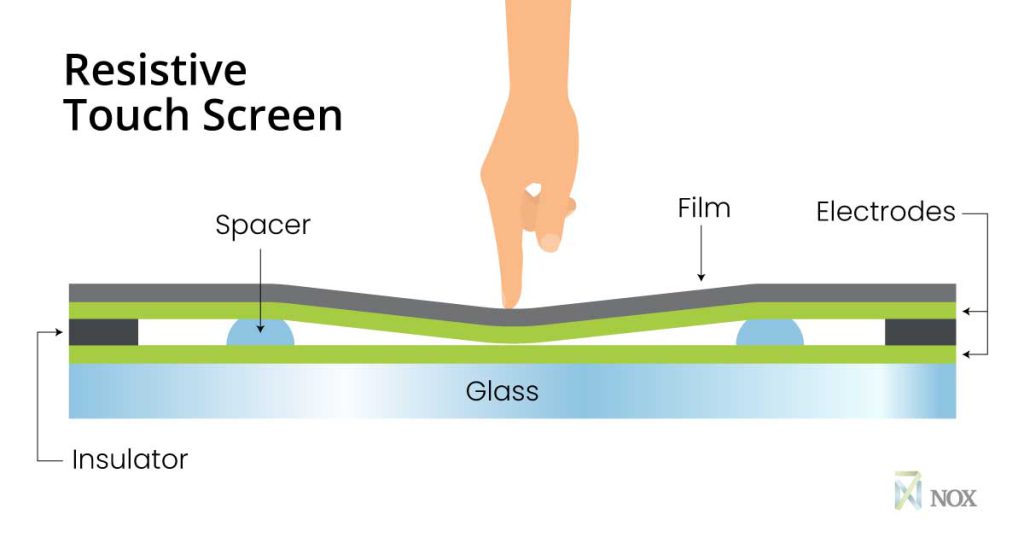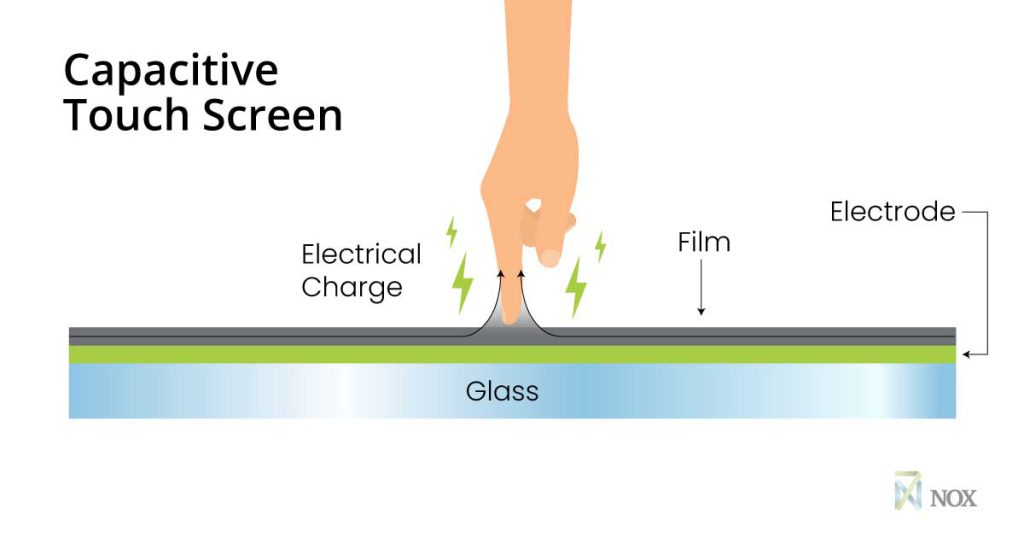Touch screens are ubiquitous. We use them at the grocery store to check out, and at the airport to check in. They’re at visitor center kiosks, our banks, our homes and even in our cars. And today, because they’re the primary interface of smartphones, touch screens are literally in our faces for 4.2 hours every day. They are the “Black Mirror” that fans of the series will know as that part of device that reflects our image back towards us.
But despite their prevalence, few know how touch screens work. It’s not because they’re a “new” technology (they’ve been around for roughly six decades). Instead, it’s likely a failure of users to fully appreciate the ingenuity that goes into solving the unique problem of connecting humans and computers through touch. To that end, here’s a quick look on the four basic types of touch screens and how they function. But first, a little touch screen 101.
How do Touch Screens Work?
All touch screens work by creating a predictable X and Y grid pattern on the surface of the screen (Think back to the coordinate plane of your primary math class). As our fingers or stylus interacts with the grid, we introduce a disturbance. The disturbance might be a fluctuation in electrical resistance, capacitance, heat or even acoustical wave flow. The screen’s sensors then detect these changes and use them to triangulate our finger/stylus position. Finally, the sensors translate our clicks and gestures to the CPU, which executes the appropriate command (e.g., “open the app”). Simple in theory, but complex in practice.
Screen Tech Tradeoffs
Like any technology, touch screens have several cost-benefit factors, and manufacturers tailor their products to maximise specific benefits for different consumer needs. One common tradeoff for touch screens is accuracy vs cost. Typically, the more accurate the screen, the more expensive, due to the extra components or more expensive materials used. Screen clarity is another consideration. Some screen designs provide 100% screen illumination, while others adopt layered screens, which can dampen resolution and brightness. Other common screen characteristics include:
- Durability vs cost
- Single vs multi-touch (i.e., two or more fingers)
- Finger touch vs stylus vs both
- Resistance to contaminants like water and oil
- Sensitivity to electromagnetic interference (EMI) or direct sunlight
- High vs low power consumption
Consumers and businesses often trade less-needed features for more desirable ones. For example, facility access screens require more durability and “touch life,” with less consideration towards clarity and multi-touch, while smartphone makers need both (and more!) to compete.

Resistive Touch Screens
The most straightforward touch screen design is the resistive touch screens (RTS). These screens employ a multi-layered design, which includes glass covered by a thin plastic film. In between these two layers is a gap with two metallic electrodes, both resistive to electricity flow. The gap is filled with a layer of air or inert gas, and the electrodes are organized in vertical and horizontal grid lines. Essentially, resistive touch screens work like an electric switch. When the user presses the screen, the two metallic layers come into contact and completes the circuit. The device then senses the exact spot of contact on the screen.
RTS are low-cost and use little power. They’re also resistant to contaminants like water and oil, since droplets can’t “press” the screen. Almost any object can interact with the screen, so even thick gloved hands are usable. However, RTS usually offer low screen clarity and less damage/scratch resistance.

Capacitive Touch Screens
One screen type you’ll find on almost every smartphone is the capacitive touch screen (CTS). These screens have three layers: a glass substrate, a transparent electrode layer and a protective layer. Their screens produce and store a constant small electrical charge or capacitance. Once the user’s finger touches the screen, it absorbs the charge and lowers the screen capacitance. Sensors located at the four corners of the screen, detect the change and determine the resulting touch point.
Capacitive screen come in two types: surface and projected (P-Cap), with the latter being the common screen type for today’s smartphones and tablets. P-Cap screens also include a thin layer of glass on top of the protective film and allows for multi-touch and thin gloved use. So, they’re popular in health care settings where users wear latex gloves.
Having fewer layers, CTS offer high screen clarity, as well as better accuracy and scratch resistance. But their electrified designs put them at risk of interference from other EMI sources. Plus, their interaction is limited to fingers and/or specialised styluses.

Surface Acoustic Wave Touch Screens
Surface Acoustic Wave (SAW) touch screens use sound waves instead of electricity. SAWs have three components: transmitting transducers, transmitting receivers, and reflectors. Together, these components produce a constant surface of acoustic waves. When a finger touches the screen, it absorbs the sound waves, which, consequently, never make it to their intended receivers. The device’s computer then uses the missing information to calculate the location of touch.
SAWs have no traditional layers, so they tend to have the best image quality and illumination of any touch screen. They have superior scratch resistance, but are susceptible to water and sold contaminants, which can trigger false “touches.”

Infrared Touch Screen
Infrared (IR) touch screens are like SAW screens; in that they contain no metallic layers. However, instead of producing ultrasonic sounds, IRs use emitters and receivers to create a grid of invisible infrared light. Once a finger or other object disrupts the flow of light beams, the sensors can locate the exact touch point. Those coordinates are then sent to the CPU for processing the command.
IR screens have superior screen clarity and light transmission. Plus, they offer excellent scratch resistance and multi-touch controls. Downsides include high cost and possible interference from direct sunlight, pooled water, and built-up dust and grime.

